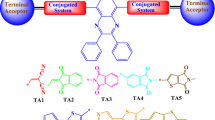Abstract
The objective of this research work is to study the nonlinear optical (NLO) response of terpyridine ligand complexes. Terpyridine ligand based compounds were studied through quantum chemical calculations by using B3LYP/6-31 g (d,p) basis sets. Density functional theory (DFT) calculations were performed to examine nonlinear optical properties of these newly designed compounds. Triphenylamine as electron donor and terpyridine ligand as an electron acceptor were connected directly. The π-spacers were also used to connect the donor and acceptor to increase conjugation. Preparation and characterization of novel compounds or materials for NLO, especially for second harmonic generation (SHG), based on hydrogen-bonded compounds of organic nitrogen containing bases such as terpyridine is used in this research work. Terpyridine ligand has ability to stabilize the complexes. Chelation and supramolecular organization play key role in designing new second-order NLO materials/compounds. NLO compounds have emerged as one of the most attractive fields of current research in view of their vital applications in areas like optical modulation, optical switching, optical logic, frequency shifting and optical data storage for the developing technologies in telecommunications and in efficient signal processing. These newly designed chromophore/compounds show high thermal stability and large optical nonlinearity. In studied compounds dye-5 has its maximum NLO response calculated to be 1967.23 a.u.
Graphical Abstract
The computed βtot values increase by increasing conjugation bridge along with the incorporation of an electron acceptor (F) at the end of terpyridine ring.






Similar content being viewed by others
References
J. P. Costes, J. F. Lamere, C. Lepetit, P. G. Lacroix, F. Dahan, and K. Nakatani (2005). Inorg. Chem. 44, (6), 1973–1982.
S. Di Bella and I. Fragalà (2000). Synth. Met. 115, (1), 191–196.
D. J. Williams (1984). Angewandte Chemie International Edition in English 23, (9), 690–703.
P. Günter Nonlinear Optical Effects and Materials (Springer, Berlin, 2012).
P. N. Prasad and D. J. Williams Introduction to Nonlinear Optical Effects in Molecules and Polymers (Wiley, New York, 1991).
D. S. Chemla Nonlinear Optical Properties of Organic Molecules and Crystals (Elsevier, Amsterdam, 2012).
M. Drozd and M. Marchewka (2005). J. Mol. Struct: Theochem 716, (1), 175–192.
M. R. S. A. Janjua (2017). J. Iran. Chem. Soc. 1–14.
M. R. S. A. Janjua, M. Amin, M. Ali, B. Bashir, M. U. Khan, M. A. Iqbal, W. Guan, L. Yan, and Z. M. Su (2012). Eur. J. Inorg. Chem. 2012, (4), 705–711.
M. R. S. A. Janjua, M. U. Khan, B. Bashir, M. A. Iqbal, Y. Song, S. A. R. Naqvi, and Z. A. Khan (2012). Comp. Theor. Chem. 994, 34–40.
K. D. Singer, J. E. Sohn, L. King, H. Gordon, H. Katz, and C. Dirk (1989). JOSA B 6, (7), 1339–1350.
J. Luo, M. Haller, H. Ma, S. Liu, T.-D. Kim, Y. Tian, B. Chen, S.-H. Jang, L. R. Dalton, and A. K.-Y. Jen (2004). J. Phys. Chem. B 108, (25), 8523–8530.
M. R. S. A. Janjua, Z.-M. Su, W. Guan, C.-G. Liu, L.-K. Yan, P. Song, and G. Maheen (2010). Aust. J. Chem. 63, (5), 836–844.
M. R. S. A. Janjua, W. Guan, L. Yan, Z.-M. Su, M. Ali, and I. H. Bukhari (2010). J. Mol. Graphics Modell. 28, (8), 735–745.
J.-M. Lehn (1993). Science 260, 1762.
Guoqiang Shi, Ying Wang, Fangfang Zhang, Bingbing Zhang, Zhihua Yang, Xueling Hou, Shilie Pan, and Kenneth R. Poeppelmeier (2017). J. Am. Chem. Soc. 139, 10645–10648.
Xuefei Wang, Ying Wang, Bingbing Zhang, Fangfang Zhang, Zhihua Yang, and Shilie Pan (2017). Angew. Chem. Int. Ed. 56, 14119–14123.
Bingbing Zhang, Guoqiang Shi, Zhihua Yang, Fangfang Zhang, and Shilie Pan (2017). Angew. Chem. Int. Ed. 56, 3916–3919.
Ying Wang, Bingbing Zhang, Zhihua Yang, and Shilie Pan (2018). Angew. Chem. Int. Ed. 57, 2150–2154.
Wu Hongping, Yu Hongwei, Zhihua Yang, Xueling Hou, Su Xin, Shilie Pan, Kenneth R. Poeppelmeier, and James M. Rondinelli (2013). J. Am. Chem. Soc. 135, 4215–4218.
Wu Hongping, Shilie Pan, Kenneth R. Poeppelmeier, Hongyi Li, Dianzeng Jia, Zhaohui Chen, Xiaoyun Fan, Yun Yang, James M. Rondinelli, and Haosu Luo (2011). J. Am. Chem. Soc. 133, 7786–7790.
Xiaoyu Dong, Qun Jing, Yunjing Shi, Zhihua Yang, Shilie Pan, Kenneth R. Poeppelmeier, Joshua Young, and James M. Rondinelli (2015). J. Am. Chem. Soc. 137, 9417–9422.
Yu Hongwei, Wu Hongping, Shilie Pan, Zhihua Yang, Su Xin, and Fangfang Zhang (2012). J. Mater. Chem. 22, 9665–9670.
Ying Wang and Shilie Pan (2016). Coord. Chem. Rev. 323, 15–35.
Xuefei Wang, Ying Wang, Bingbing Zhang, Fangfang Zhang, Zhihua Yang, and Shilie Pan (2017). Angew. Chem. Int. Ed. 129, 14307–14311.
Acknowledgements
M.R.S.A. Janjua would like to acknowledge the support provided by the Deanship of Scientific Research (DSR) at King Fahd University of Petroleum & Minerals (KFUPM) for funding this work through Project No. SR161009.
Author information
Authors and Affiliations
Corresponding author
Rights and permissions
About this article
Cite this article
Janjua, M.R.S.A. Structure–Property Relationship and Systematic Study of a Series of Terpyridine Based Nonlinear Optical Compounds: DFT Computation of Interactive Design. J Clust Sci 30, 45–51 (2019). https://doi.org/10.1007/s10876-018-1458-3
Received:
Published:
Issue Date:
DOI: https://doi.org/10.1007/s10876-018-1458-3




